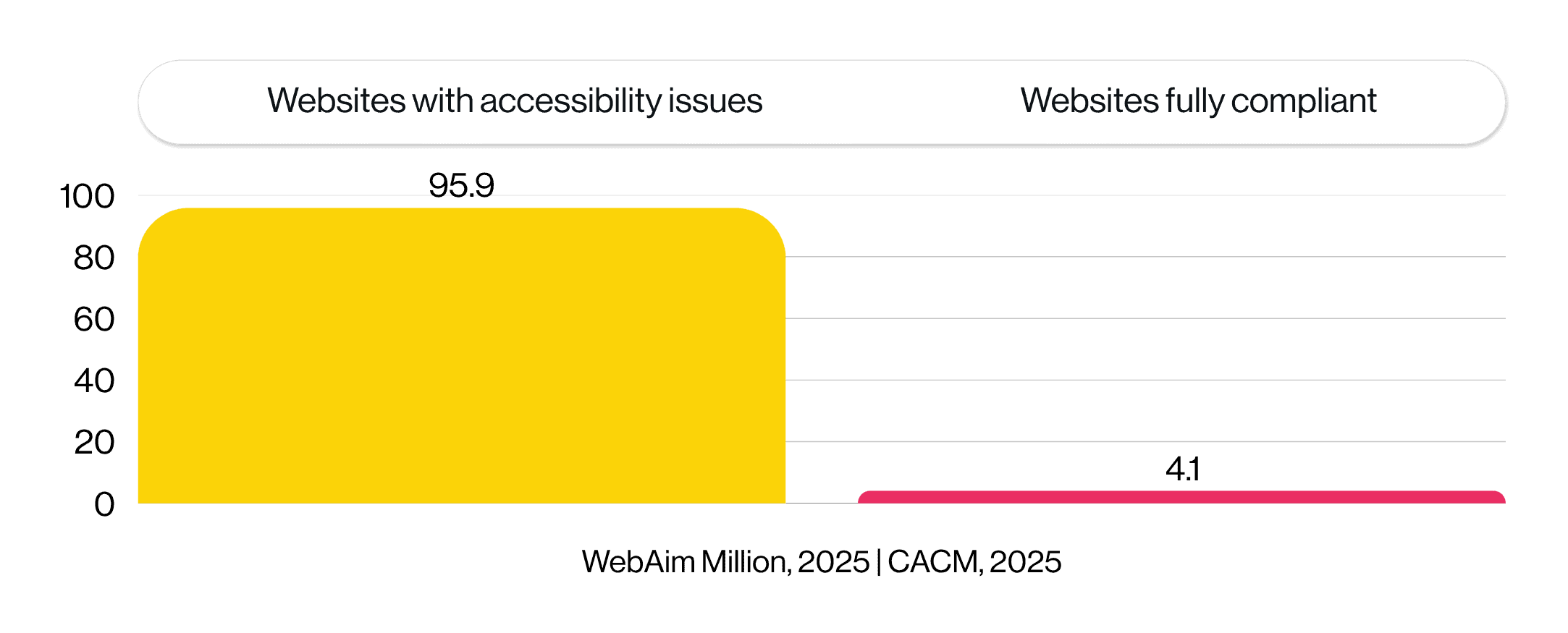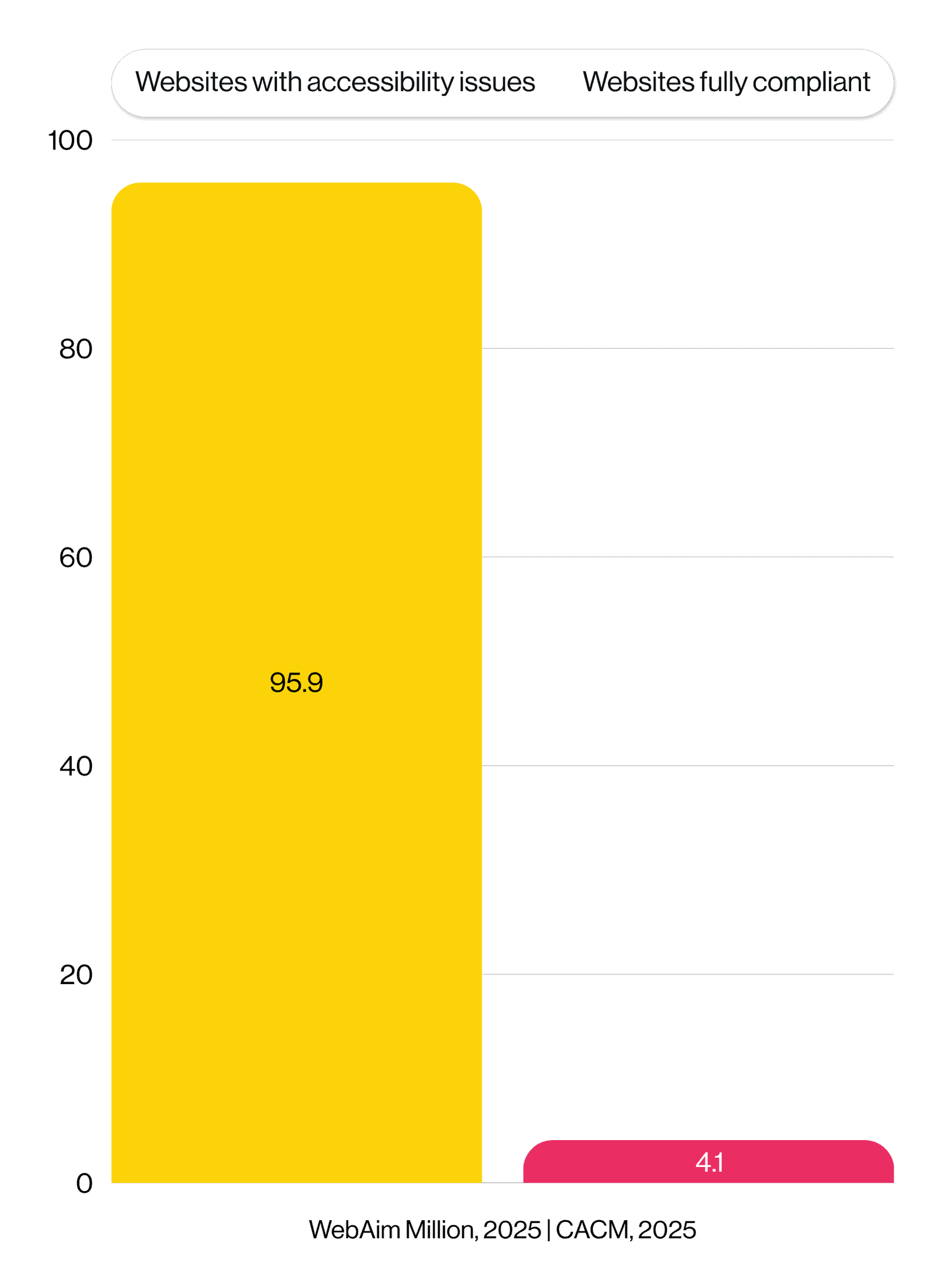Accessible Government Websites
Building Trust, Transparency, and Equity Online: Why it Matters
By Tristan Pittard and Marisa Crocker | October 10, 2025
Public sector websites, whether government agencies, nonprofits, or educational institutions, are more than digital information centers. They are the gateway to trust, transparency, and inclusion. When designed with accessibility at their core, they ensure all communities can engage fully with public services. From compliance with federal standards to fostering equitable access, accessible websites strengthen civic participation and reinforce the mission of public sector organizations.
By prioritizing accessibility, public sector organizations can reduce barriers, strengthen engagement, and set a higher standard for public service in the digital age.
This is the first installment in our series on government website accessibility, exploring why it matters, how to implement it, and how to sustain it. Download the primer ↓
The Role of Accessibility in Public Sector Websites
Accessibility Failures
Inaccessible sites make tasks 10x harder for assistive tech users (CACM, 2025). With 96% of top websites still showing errors (WebAIM, 2025), public institutions face the same accessibility challenges.


What Accessibility Really Means
Accessibility is more than compliance with WCAG 2.1/2.2 or Section 508. Compliance is essential, but true accessibility is about creating digital spaces that reflect the diversity of the communities they serve.
Findings from the (WebAIM Million, 2025) show that 95.9% of the world’s top sites still contain accessibility issues, averaging 56.8 errors per page. Public sector organizations, from federal agencies to local nonprofits, consistently struggle with accessibility gaps that impact everyday use and mission fulfillment.
True accessibility means:
- Intuitive navigation
- Mobile-first design
- Plain language
- Inclusive multimedia
When these elements come together, everyone—regardless of ability—can fully engage with civic services, higher-ed resources, and nonprofit programs.
Impact on the Public
Accessibility barriers aren’t small inconveniences. They cut people off from essential services like healthcare, benefits, education, and civic participation. For those relying on assistive technologies, simple online tasks take up to ten times longer, turning daily interactions into frustration and lost trust (CACM, 2025).
For nonprofits and civic organizations, inaccessible websites don’t just frustrate users—they undermine mission impact. A food bank with an inaccessible volunteer signup form can’t feed as many families. A university with inaccessible course materials fails students with disabilities. An advocacy organization with an inaccessible petition platform silences the voices it aims to amplify.
As the CACM report emphasizes, accessibility is more than a compliance requirement. It is a human right, a business imperative, and for public-sector organizations, a critical measure of equity and accountability.
Inaccessible content forces offline help, raising costs
Efficiency
Agencies risk lawsuits, credibility, and compliance failures
Risk
Inclusive websites ensure democratic participation and trust
Equity
Accessibility as a Catalyst for Efficiency and Trust
Driving Efficiency
Accessible websites reduce costs and improve service delivery. When people can easily access information online, agencies reduce the burden on call centers, in-person offices, and paper-based processes.
A Cornell study on website accessibility found that while 90% of federal domains displayed accessibility statements, 55% still required remediation, and 73% of PDFs were untagged and inaccessible. These gaps force people to seek help offline, driving up costs and slowing service delivery.
By prioritizing accessibility, public sector organizations can reduce barriers, strengthen engagement, and set a higher standard for public service in the digital age.
Reducing Risk
Neglecting accessibility creates more than user frustration. It introduces legal, financial, and reputational risk. The Information Technology and Innovation Foundation found that 30% of federal homepages and nearly half of popular subpages failed automated accessibility tests (Cornell URJ, 2023).
At the same time, ADA-related lawsuits continue to rise, with thousands filed every year (Seyfarth Shaw ADA Litigation Report, 2023).
Building Equity
Accessibility is equity in action. Across federal, state, higher-ed, and nonprofit levels, inaccessible websites create real exclusion.
- A city website without alt text leaves blind residents uninformed about essential services
- A nonprofit’s donation portal with poor contrast frustrates donors with low vision
- A university’s course registration system without keyboard navigation blocks students with mobility disabilities
- A state benefits portal with untagged PDFs makes assistance inaccessible
- A civic organization’s event calendar with poor navigation discourages community engagement
When public-facing websites fall short, people lose trust. Inclusive design restores equity and strengthens democracy.
Community Connections
Diverse Needs
Assistive Tech
Government Websites
Plain Language
Mobile-First
Inclusive Design
Access to Services
Voting
Civic Info
Events
Human-Centered Design in Public Services
Nurturing Engagement
Civic, higher ed, and nonprofit websites designed with human-centered principles empower people by making services easier to find, understand, and use. When navigation is clear and content is written in plain language, people experience less frustration and greater confidence in the institutions they rely on.
Prioritizing Accessibility
Accessibility is more than meeting technical requirements. It is about ensuring that every element of a site communicates transparency and accountability. Clear content, simple layouts, and accessible multimedia invite communities into the conversation rather than leaving them behind. These design choices show public trust in action.
Technology as a Strategic Tool
WordPress VIP and Mandala Creative
Accessibility becomes sustainable when it is paired with the right technology. As a WordPress VIP public sector partner, Mandala Creative delivers websites that unite enterprise-grade security and performance with accessibility-first, people-focused design. Our approach includes:
- Built-in accessibility testing integrated into the development workflow
- Component libraries pre-tested for WCAG 2.2 AA compliance
- Editor guardrails that prevent content creators from inadvertently introducing accessibility issues
- Automated monitoring that catches new issues before they reach the public
This isn’t just about fixing problems—it’s about preventing them from happening in the first place.
Strategic Integration
Technology also allows agencies to go beyond compliance and create seamless digital experiences. From integrated service portals and online forms to multilingual content and responsive design, accessible platforms improve efficiency while promoting inclusivity. When technology is paired with thoughtful design, it becomes a driver of trust, equity, and stronger public engagement.
Accessible, secure, and future-ready government websites together
Access Builds Trust
Accessible websites are more than compliant. They are community-focused platforms for equity, efficiency, and engagement.
When public agencies pair accessibility with human-centered design, they build digital spaces that inform, include, and inspire confidence.
At Mandala Creative, we bring design expertise, compliance knowledge, and enterprise technology together through our partnership with WordPress VIP to help agencies deliver accessible, secure, and people-focused websites that strengthen public trust.
In This Series
This is the first in our series on public sector website accessibility. In upcoming posts, we’ll provide practical, step-by-step guidance on:
- Conducting your first accessibility audit – Free tools, manual testing procedures, and prioritization frameworks
- The Big 5 accessibility fixes – How to resolve the most common issues on public sector sites
- Plain language and cognitive accessibility – The most overlooked WCAG requirement
- Making PDFs and documents accessible – Why 73% of documents fail accessibility standards and how to fix them
- Accessibility on limited budgets – Prioritizing fixes when resources are constrained
- Accessibility in procurement and vendor selection – Building requirements into RFPs, grants, and platform choices
- Accessible donation and fundraising platforms – Ensuring supporters of all abilities can contribute
- Governance and ongoing compliance – Who owns accessibility after launch?
Want to share this with your team?
Use this form to Download the Accessibility in Government & Public Sector Websites Primer as a PDF — perfect for sharing with stakeholders, referencing in meetings, or keeping as a resource.
Plus, get notified when we publish the next post in this series with our step-by-step accessibility audit guide.
References
Droutsas, S., et al. (2025). Automated Web Accessibility Evaluation and Impact Assessment Framework. Computer Standards & Interfaces, Elsevier, DOI. https://doi.org/10.1016/j.csi.2024.103020
WebAIM. (2025). WebAIM Million Report. https://webaim.org/projects/million/
CACM. (2025). The State of Digital Accessibility. https://cacm.acm.org/practice/the-state-of-digital-accessibility/
Cornell Undergraduate Research Journal. (2023). Government Website Inaccessibility and the Future of Accessibility in Information Technology. https://journals.library.cornell.edu/index.php/CURJ/article/view/736
W3C. (2023). Web Content Accessibility Guidelines (WCAG) 2.1/2.2. https://www.w3.org/WAI/standards-guidelines/wcag/
Section508.gov. (2023). Section 508 Standards. https://www.section508.gov/
Digital.gov. (2023). Introduction to Accessibility. https://digital.gov/resources/introduction-accessibility/
Seyfarth Shaw LLP. (2023). ADA Website Accessibility Litigation Report. https://www.adatitleiii.com/
WordPress VIP. (2025). Enterprise WordPress Platform. https://wpvip.com/
Image credits
Wetselaar, H.G, (1926-) europeana.eu, Ante Gudelj on Unsplash, Paris Bilal on Unsplash, Robert Harkness on Unsplash, Wilhelm Gunkel on Unsplash, Markus Kammermann on Unsplash, Stéphan Valentin on Unsplash
